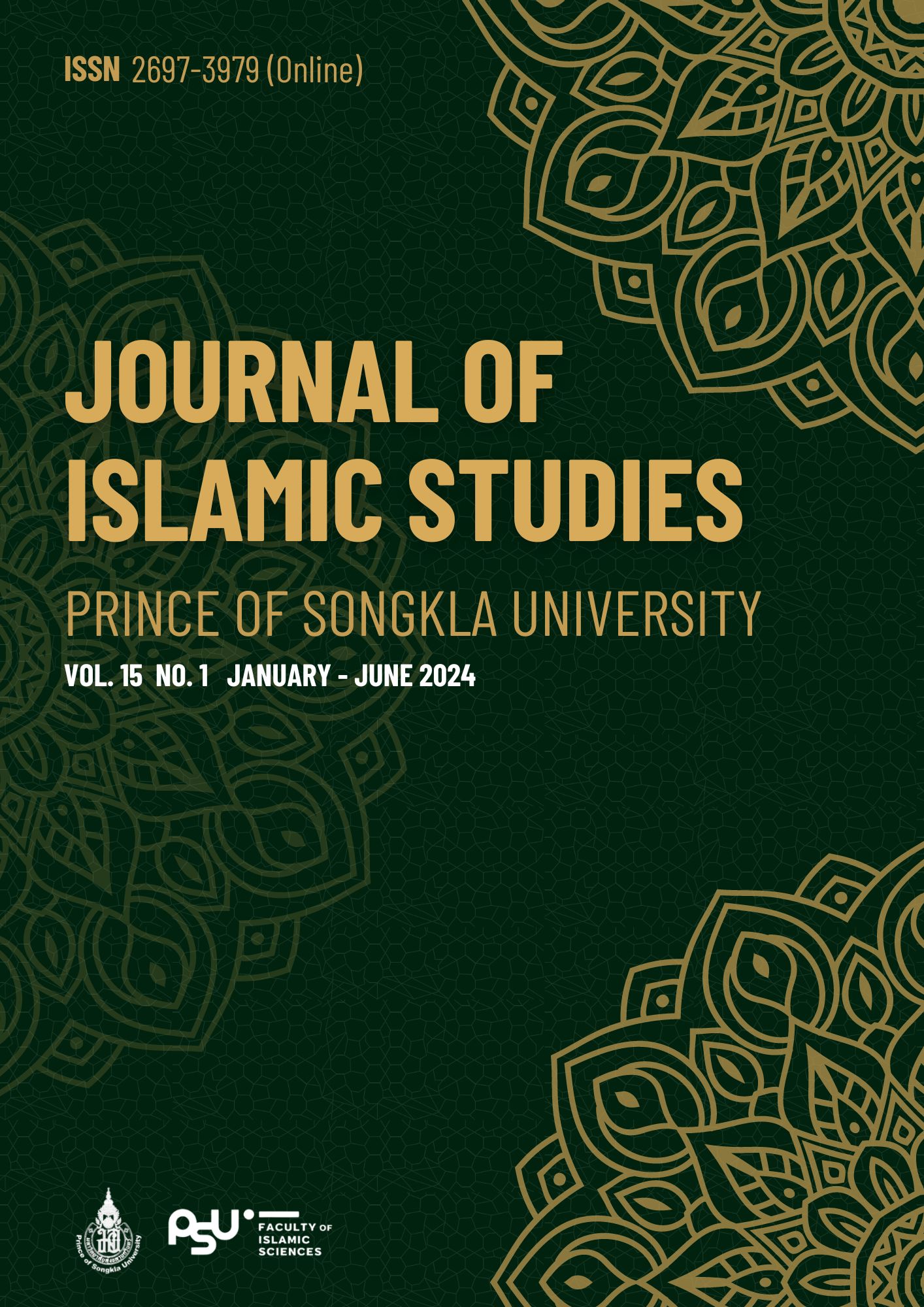การพัฒนาทักษะการคิดวิเคราะห์โดยใช้กระบวนการ QSCCS รายวิชาอัลหะดีษสำหรับนักเรียนชั้นประถมศึกษาปีที่ 6
คำสำคัญ:
พัฒนาทักษะ, ทักษะการคิดวิเคราะห์, อัลหะดีษ, QSCCSบทคัดย่อ
จุดประสงค์ 1) เพื่อหาประสิทธิภาพของแผนการจัดการเรียนรู้แบบ QSCCS รายวิชาอัลหะดีษ สำหรับนักเรียนชั้นประถมศึกษาปีที่ 6 ให้มีประสิทธิภาพตามเกณฑ์ 70/70 2) เพื่อพัฒนาทักษะการคิดวิเคราะห์ โดยใช้กระบวนการQSCCS รายวิชาอัลหะดีษ สำหรับนักเรียนชั้นประถมศึกษาปีที่ 6 โดยใช้เกณฑ์ร้อยละ 70 3) เพื่อเปรียบเทียบผลการเรียนรู้ของนักเรียนก่อนและหลังเรียนจากแผนการจัดการเรียนรู้แบบ QSCCS รายวิชาอัลหะดีษ สำหรับนักเรียนชั้นประถมศึกษาปีที่ 6 4) เพื่อศึกษาความพึงพอใจของนักเรียนชั้นประถมศึกษาปีที่ 6 ต่อการจัดการเรียนรู้แบบ QSCCS รายวิชาอัลหะดีษ
วิธีการศึกษา ประชากรเป้าหมายที่ใช้ในการวิจัยครั้งนี้ ได้แก่ นักเรียนชั้นประถมศึกษาปีที่ 6 โรงเรียน บ้านบาตูมิตรภาพที่ 66 ตำบลปะลุกาสาเมาะ อำเภอบาเจาะ จังหวัดนราธิวาส ภาคเรียนที่ 2 ปีการศึกษา 2565 จำนวน 25 เครื่องมือที่ใช้ในการวิจัยประกอบด้วย 1) แผนจัดการเรียนรู้โดยใช้กระบวนการ QSCCS จำนวน 5 แผน 2) แบบประเมินทักษะการคิดวิเคราะห์ จำนวน 30 ข้อ 3) แบบทดสอบวัดผลสัมฤทธิ์ทางการเรียนก่อนเรียนจำนวน 30 ข้อและหลังเรียนจำนวน 30 ข้อ 4) แบบประเมินความพึงพอใจของนักเรียนที่มีต่อการจัดการเรียนรู้ สถิติที่ใช้ในการวิจัยคือ ค่าเฉลี่ยค่าเบี่ยงเบนมาตรฐานและค่า t-test
ผลการศึกษา พบว่า 1) ประสิทธิภาพของแผนการจัดการเรียนรู้โดยใช้กระบวนการ QSCCS มีประสิทธิภาพตามเกณฑ์ 70/70= 80.83/82.50 ซึ่งมีประสิทธิภาพสูงกว่าเกณฑ์ 2) ทักษะการคิดวิเคราะห์ผ่านเกณฑ์ร้อยละ70 = 83.60 3) ผลของการเรียนรู้หลังเรียนสูงกว่าก่อนเรียนจากค่าเฉลี่ยอยู่ที่ (24.80 > 17.40) ซึ่งมีความแตกต่างกันทางสถิติที่ระดับ 0.05 4) ความพึงพอใจของนักเรียนต่อการจัดการเรียนรู้มีความพึงพอใจอยู่ในระดับ มาก (xˉ = 4.34, S.D. = 0.26)
การนำผลวิจัยไปใช้ บทความวิจัยนี้สามารถนำไปใช้ประโยชน์ทางวิชาการ พัฒนารูปแบบการจัดการเรียนการสอนอิสลามศึกษา
เอกสารอ้างอิง
Batu School. (2021). Education Quality Development Plan. Batu School.
Bloom, B. S. (1956). Taxonomy of educational objectives: The classification of educational goals (1st ed.). Longman Group.
Duron, R., Limbach, B., & Waugh, W. (2006). Critical Thinking Framework for Any Discipline. International Journal of Teaching and Learning in Higher Education, 17(2), 160-166. https://www.isetl.org/ijtlhe/pdf/IJTLHE55.pdf
Ibn Majah al-Qazwaini, M. Y. (2007). Sunan Ibnu Majah. Dar al-Salam.
Mahae, S. (2021). The Development of Reading and Memorizing Vocabularies of Al-Hadith by Using Story Book Primary School Students Year 5 [Unpublished master’s thesis]. Yala Rajabhat University.
Muangthai, K. (2018). Results of Learning Activity Management Using 5 STEPs Approach on Subject-Verb Agreement for 1st Year English Major Students of the Faculty of Education Nakhon Phanom University. Journal of Humanities and Social Sciences Surin Rajabhat University, 20(2), 64-75.
Naoungon S., & Sittiwong, T., & Jiraworapong, P. (2018). The Flipped Classroom and Team Based Learning on General Education for Undergraduate Students. Journal of Education Silpakorn University, 14(1), 45-53.
Office of Academic Affairs and Educational Standards, OBEC. (2008). Basic Education Core Curriculum B.E. 2551 (A.D. 2008). The Ministry of Education.
Rattanarasee, K., & Janthorn, B. (2018). Development of Academic Achievement by Implementing 5 Steps of Learning Activities (QSCCS) in Advanced Office Software Course Offered to First-Year Diploma Students at Panyapiwat Technological College. Journal of Innovation and Technology for Learning (JTL) Siam Technology College 1(1), 38-48. https://doi.nrct.go.th// ListDoi/listDetail?Resolve_DOI=10.14456/jtl.2018.5
Srisayan, W. (2020). The 5-Step Learning Management Approach for Critical Reading Skills Development in the Thai Language Course of Matthayomsuksa 3 Bandaitepkanjanaubhatham School Mae Sai District Chiangrai Province. Journal Graduate School Chiangmai Rajabhat University, 16(1), 69-80. https://so01.tci-thaijo.org/index.php/pikanasan/article/view/226404
Srithongsook, C. (2018). The Development of Analytical Thinking Ability and Geographical Concepts in Europe of Matthayomsuksa 2 Students Taught By 5 Steps with Infographic. Veridian E-Journal, Silpakorn University, 12(5), 1360-1375. https://he02.tci-thaijo.org/index.php/Veridian-E-Journal/article/view/186951
The Old Arab Students Association of Thailand. (1998). prá má-hăa kam-pee an gù raan próm bplae bpen paa-săa tai [The Holy Quran with Thai translations]. King Fahad Center for Printing the Quran.
The Royal Institute. (2003). pót-jà-naa-nú-grom chà-bàp râat-chá-ban-dìt-dtà-yá-sà-tăan · พ · ศ · 2542 [Royal Institute Dictionary B.E. 2542]. Nanmeebook Publication.
Theptee, K. (2015). Effects of organizing learning activity using KWDL techniques on mathematics word problem-solving ability and learning retention on systems of linear equations in two variables [Unpublished master’s thesis]. Ubon Ratchathani University. https://www.esanpedia.oar.ubu.ac.th/e-research/?q=node/1592
Wittayarungrueangsri, M. (2021). The Five Steps Learning Management with Google Classroom in the Basic Units of Life for Enhancing Analytical Thinking and Academic Achievement of Mathayomsuksa 1 Students. Rajabhat Mahasarakham University. https://fulltext.rmu.ac.th/fulltext/2564/M130239/Wittayarungrueangsri%20Manassanan.pdf
ดาวน์โหลด
เผยแพร่แล้ว
รูปแบบการอ้างอิง
ฉบับ
ประเภทบทความ
สัญญาอนุญาต
ลิขสิทธิ์ (c) 2024 วารสารอิสลามศึกษา มหาวิทยาลัยสงขลานครินทร์

อนุญาตภายใต้เงื่อนไข Creative Commons Attribution-NonCommercial-NoDerivatives 4.0 International License.
บทความทุกเรื่อง ที่ได้รับการตีพิมพ์ในวารสารอิสลามศึกษาเป็นแนวคิดของผู้เขียน มิใช่เป็นความคิดเห็นคณะผู้จัดทำและมิใช่ความรับผิดชอบของคณะวิทยาการอิสลาม กองบรรณาธิการไม่สงวนสิทธิ์การคัดลอก แต่ให้มีการอ้างอิงแสดงที่มา




